The
Aniakchak River in the Alaska Peninsula may be the most fascinating river trip
we offer. The river is in a very remote region of Alaska with extreme conditions.
This trip is recommended for hardy travelers. After an hour charter flight from
the town of King 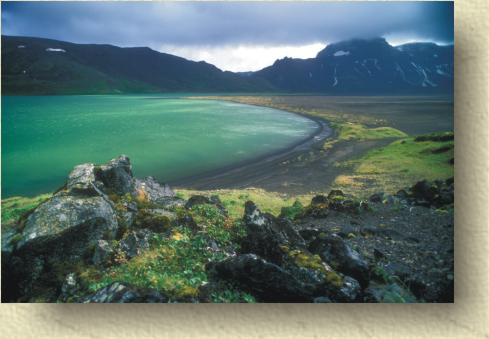 Salmon, you land in
the crater of an active volcano on the most
beautiful emerald-green lake you can imagine. The crater floor reminds some of Ngoro
Ngoro in Africa - abundant wildlife that seldom leaves the crater and
lush, grassy meadows surrounding
Salmon, you land in
the crater of an active volcano on the most
beautiful emerald-green lake you can imagine. The crater floor reminds some of Ngoro
Ngoro in Africa - abundant wildlife that seldom leaves the crater and
lush, grassy meadows surrounding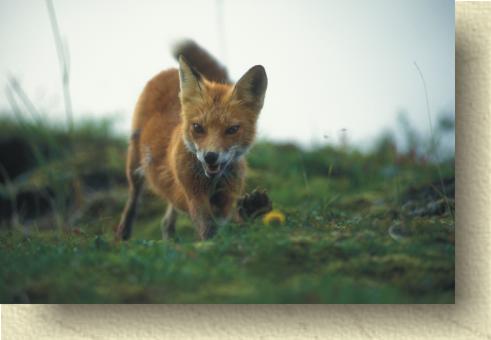 cinder cones, steam vents and carbonate
springs.
The crater is a fascinating place to explore and offers days of
fantastic hiking. Vent Mountain, the highest point in the caldera rises 2,200
feet above the valley floor and makes for a great day hike and magnificent
views. The fishing is good at the mouth of the river for char and for sockeye
salmon that swim all the way up into the lake from the Gulf of Alaska in late
July and August. Wildlife in the crater includes caribou, brown bears, wolves,
wolverines and foxes. It seems improbable that so much wildlife would live in
this extreme environment, but here they thrive.
cinder cones, steam vents and carbonate
springs.
The crater is a fascinating place to explore and offers days of
fantastic hiking. Vent Mountain, the highest point in the caldera rises 2,200
feet above the valley floor and makes for a great day hike and magnificent
views. The fishing is good at the mouth of the river for char and for sockeye
salmon that swim all the way up into the lake from the Gulf of Alaska in late
July and August. Wildlife in the crater includes caribou, brown bears, wolves,
wolverines and foxes. It seems improbable that so much wildlife would live in
this extreme environment, but here they thrive.
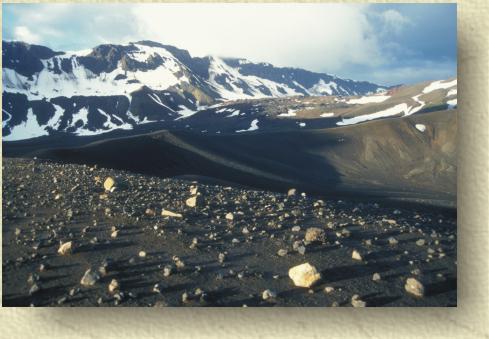 Aniakchak
volcano rose to a height of 7,000 feet until an eruption 3,500 years ago caused
it to collapse in on itself. The result was a massive caldera 6 miles across and
completely enclosed. The caldera filled with water over time forming a lake
similar to Oregonís Crater Lake. About
2,000 years ago, the crater rim
collapsed and the water escaped through the V-shaped notch now known as The
Gates. Surprise Lake is all that is left of this once huge lake. The caldera
became an oasis of rich plant and animal life that early explorers described as
a paradise. In 1931, Vent Mountain erupted in a cataclysmic blast that destroyed
all plant and animal life within the caldera. The lake turned black, molten lava
covered the floor of the caldera, sulfur fumes filled the air and the ground for
miles around was covered with thick volcanic ash. Paradise had turned to hell.
The caldera is slowly returning to normal. Lichens, grasses and flowering plants
have begun to grow in the rich volcanic ash and birds and mammals have followed.
Aniakchak
volcano rose to a height of 7,000 feet until an eruption 3,500 years ago caused
it to collapse in on itself. The result was a massive caldera 6 miles across and
completely enclosed. The caldera filled with water over time forming a lake
similar to Oregonís Crater Lake. About
2,000 years ago, the crater rim
collapsed and the water escaped through the V-shaped notch now known as The
Gates. Surprise Lake is all that is left of this once huge lake. The caldera
became an oasis of rich plant and animal life that early explorers described as
a paradise. In 1931, Vent Mountain erupted in a cataclysmic blast that destroyed
all plant and animal life within the caldera. The lake turned black, molten lava
covered the floor of the caldera, sulfur fumes filled the air and the ground for
miles around was covered with thick volcanic ash. Paradise had turned to hell.
The caldera is slowly returning to normal. Lichens, grasses and flowering plants
have begun to grow in the rich volcanic ash and birds and mammals have followed.
This
float trip can be done in 3 days with a day at the front and back end, but I
always recommend at least 7 days to insure time for hiking and weather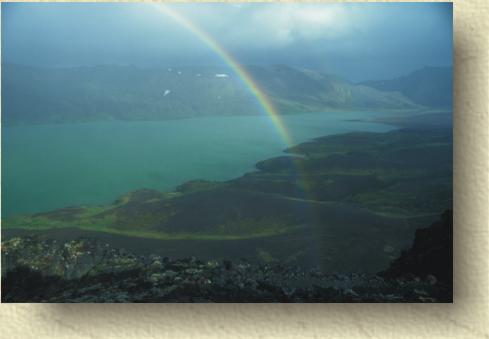 days. The
big unknown, and perhaps the biggest factor, in planning a trip to Aniakchak
is the weather. We
could spend 3 days in King Salmon
waiting to fly in and we could wait 3 days on the coast for a pick up. The
caldera is typically cloud covered and windy making it difficult for planes to
come in over the crater rim or come through the high and narrow Gates. When the
weather is good in King Salmon it may be socked in at Aniakchak and the pilots
have no one to call for a weather report. We may fly 90 minutes to the caldera only
to turn around and fly 90 minutes back and try another day. Once on the trip, the
weather is always unpredictable and often extreme. In a time span of one hour
from our camp in the crater, I have seen snow, fog, rain, hail, warm sun and
blue sky and always the wind.
days. The
big unknown, and perhaps the biggest factor, in planning a trip to Aniakchak
is the weather. We
could spend 3 days in King Salmon
waiting to fly in and we could wait 3 days on the coast for a pick up. The
caldera is typically cloud covered and windy making it difficult for planes to
come in over the crater rim or come through the high and narrow Gates. When the
weather is good in King Salmon it may be socked in at Aniakchak and the pilots
have no one to call for a weather report. We may fly 90 minutes to the caldera only
to turn around and fly 90 minutes back and try another day. Once on the trip, the
weather is always unpredictable and often extreme. In a time span of one hour
from our camp in the crater, I have seen snow, fog, rain, hail, warm sun and
blue sky and always the wind.
Bears
are another risk as this region is prime habitat. The river appears to have the
same bear population as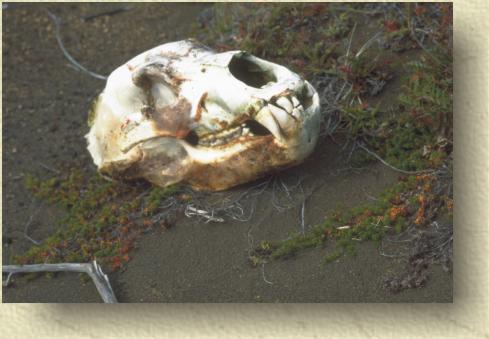 the Alagnak. The brown bears here are numerous and can
be huge but strangely not often seen. We always see plenty of bear signs all
along the river - fresh tracks and scat everywhere. When we land on shore we
often see steaming scat and half eaten salmon still flopping on the beach but
not too many bears. They were always close by, but they definitely avoided us. I
think because this river receives so few visitors the bears have a healthy
respect for people.
the Alagnak. The brown bears here are numerous and can
be huge but strangely not often seen. We always see plenty of bear signs all
along the river - fresh tracks and scat everywhere. When we land on shore we
often see steaming scat and half eaten salmon still flopping on the beach but
not too many bears. They were always close by, but they definitely avoided us. I
think because this river receives so few visitors the bears have a healthy
respect for people.
The
float trip starts from our camp on the lower lake near the river mouth. After a
mile of flat water, the current increases dramatically as the river begins it
decent through The Gates. Here it forms its first large 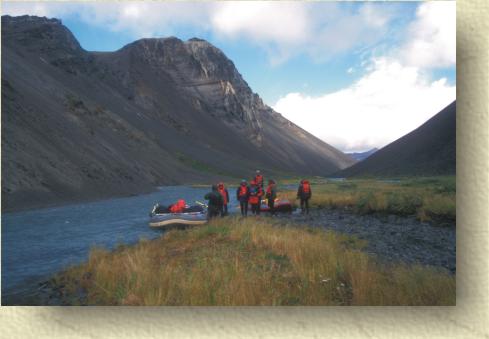 rapid rated as class 4.
This rapid is dangerous because of the large and jagged volcanic bombs that
dropped into the river after the last eruption. The river has not yet had time
to erode these large blocks of stone or channel around them. We will carefully
line the boats through these rapids and portage the large gear along the canyon
wall. For the next 15 miles, the river forms numerous class 2, 3 and, at higher
water levels, class 4 whitewater rapids. Some of these falls are quite
challenging to maneuver through, but all are exciting. One very swift rapid is
constricted within a narrow gorge (a canal really) of basaltic
rapid rated as class 4.
This rapid is dangerous because of the large and jagged volcanic bombs that
dropped into the river after the last eruption. The river has not yet had time
to erode these large blocks of stone or channel around them. We will carefully
line the boats through these rapids and portage the large gear along the canyon
wall. For the next 15 miles, the river forms numerous class 2, 3 and, at higher
water levels, class 4 whitewater rapids. Some of these falls are quite
challenging to maneuver through, but all are exciting. One very swift rapid is
constricted within a narrow gorge (a canal really) of basaltic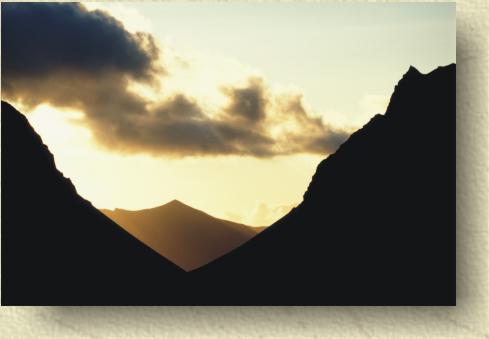 columns causing
boats to be bounced from wall to wall like a pinball. Every bounce off the
canyon wall threatens to rip a hole in the boat tubes. Fortunately, the river
gives you breaks just when you need them to pull out and tighten up, strap down
or repair. The landscape surrounding this stretch of river is magnificent and
the camping is fine. The open tundra and ash-covered terrain allow beautiful
views of the caldera and the surrounding mountains. Numerous streams and springs
flow into the river, and the riverbanks and tundra hills are covered in wild
flowers. Hiking from the river anywhere along here is very good.
columns causing
boats to be bounced from wall to wall like a pinball. Every bounce off the
canyon wall threatens to rip a hole in the boat tubes. Fortunately, the river
gives you breaks just when you need them to pull out and tighten up, strap down
or repair. The landscape surrounding this stretch of river is magnificent and
the camping is fine. The open tundra and ash-covered terrain allow beautiful
views of the caldera and the surrounding mountains. Numerous streams and springs
flow into the river, and the riverbanks and tundra hills are covered in wild
flowers. Hiking from the river anywhere along here is very good.
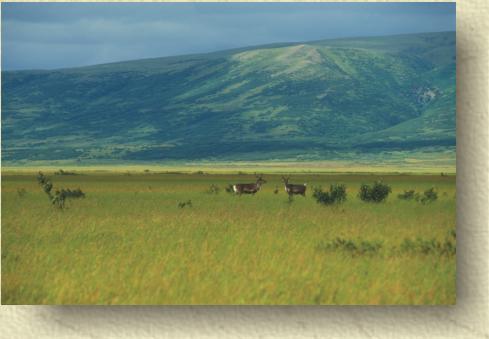 The
river leaves the mountainous terrain just beyond the boundaries of Aniakchak
National Monument and immediately the current decreases to class 1. At this
point an interesting option is to portage over a small pass to Meshik Lake and
run the Meshik River to the Bering Sea. This
makes for a truly epic adventure
but easily triples the logistical problems. For those continuing on, the river
enters a broad, willow-covered valley as it braids and meanders for the next 17
miles to the sea. The river slows considerably for the last few miles as it
rounds Cape horn and enters Aniakchak Bay. Headwinds and an incoming tide can
make this last mile rough and slow going as we make our way into the surf and
look for a camp site on the beach. The weather can be windy and rainy in the
bay, but the coastline is beautiful and the wildlife such as sea lions and sea
birds can be impressive.
The
river leaves the mountainous terrain just beyond the boundaries of Aniakchak
National Monument and immediately the current decreases to class 1. At this
point an interesting option is to portage over a small pass to Meshik Lake and
run the Meshik River to the Bering Sea. This
makes for a truly epic adventure
but easily triples the logistical problems. For those continuing on, the river
enters a broad, willow-covered valley as it braids and meanders for the next 17
miles to the sea. The river slows considerably for the last few miles as it
rounds Cape horn and enters Aniakchak Bay. Headwinds and an incoming tide can
make this last mile rough and slow going as we make our way into the surf and
look for a camp site on the beach. The weather can be windy and rainy in the
bay, but the coastline is beautiful and the wildlife such as sea lions and sea
birds can be impressive.
RIVER DATA:
Floating distance 36 miles. Minimum 5 days.
ROUTE: From
Anchorage, the first leg of the trip will be a commercial flight by jet
or commuter prop plane to the town of
King Salmon 200 miles SW of Anchorage. In King Salmon we will
charter DeHavilland Beavers or Otters that will take off from the Naknek
River to fly to Surprise Lake after an hour and a half long flight
across the open tundra of the Alaska Peninsula. The next few days will
be spent hiking the caldera floor before we set off down the lake to the
river mouth a few miles below. After 4 to 5 days on the river we will
reach the Pacific Coast. Our pickup will be by beaver or otter at
Aniakchak Bay then a charter flight 2 hours back to King Salmon. For the Meshik option, pickup will be in Port Heiden
by wheeled aircraft.
WEATHER: Summer weather in the
southern part of the Alaska Peninsula is cooler and windier than the
rest of the Peninsula. Temperature may range from as high as 70 degrees
on calm, sunny days to the mid 40s F on cloudy days. Beginning in mid to
late August you can expect freezing temperatures on clear, calm nights
warming to the low 60s the following day. By mid September, daytime
temperatures can dip to near freezing and snow can be expected anytime.
This region receives 30 to 35 inches of precipitation annually spread
evenly throughout the year. In the summer, August and September are the
rainier months. Storms are powerful and can
blow up at anytime. In the caldera or on the river, the wind can come up
quickly and blow ferociously. Sustained winds reaching 100 mph are not
uncommon. When fronts come through or pressure cells collide between the
cold Bering Sea and the warmer Pacific Ocean, the wind blows and is
magnified by the venturi effect of the Aleutian Mountain passes.
Aniakchak
Trip Slide Show
 Salmon, you land in
the crater of an active volcano on the most
beautiful emerald-green lake you can imagine. The crater floor reminds some of Ngoro
Ngoro in Africa - abundant wildlife that seldom leaves the crater and
lush, grassy meadows surrounding
Salmon, you land in
the crater of an active volcano on the most
beautiful emerald-green lake you can imagine. The crater floor reminds some of Ngoro
Ngoro in Africa - abundant wildlife that seldom leaves the crater and
lush, grassy meadows surrounding
 Aniakchak
volcano rose to a height of 7,000 feet until an eruption 3,500 years ago caused
it to collapse in on itself. The result was a massive caldera 6 miles across and
completely enclosed. The caldera filled with water over time forming a lake
similar to Oregonís Crater Lake. About
2,000 years ago, the crater rim
collapsed and the water escaped through the V-shaped notch now known as The
Gates. Surprise Lake is all that is left of this once huge lake. The caldera
became an oasis of rich plant and animal life that early explorers described as
a paradise. In 1931, Vent Mountain erupted in a cataclysmic blast that destroyed
all plant and animal life within the caldera. The lake turned black, molten lava
covered the floor of the caldera, sulfur fumes filled the air and the ground for
miles around was covered with thick volcanic ash. Paradise had turned to hell.
The caldera is slowly returning to normal. Lichens, grasses and flowering plants
have begun to grow in the rich volcanic ash and birds and mammals have followed.
Aniakchak
volcano rose to a height of 7,000 feet until an eruption 3,500 years ago caused
it to collapse in on itself. The result was a massive caldera 6 miles across and
completely enclosed. The caldera filled with water over time forming a lake
similar to Oregonís Crater Lake. About
2,000 years ago, the crater rim
collapsed and the water escaped through the V-shaped notch now known as The
Gates. Surprise Lake is all that is left of this once huge lake. The caldera
became an oasis of rich plant and animal life that early explorers described as
a paradise. In 1931, Vent Mountain erupted in a cataclysmic blast that destroyed
all plant and animal life within the caldera. The lake turned black, molten lava
covered the floor of the caldera, sulfur fumes filled the air and the ground for
miles around was covered with thick volcanic ash. Paradise had turned to hell.
The caldera is slowly returning to normal. Lichens, grasses and flowering plants
have begun to grow in the rich volcanic ash and birds and mammals have followed.
 the Alagnak. The brown bears here are numerous and can
be huge but strangely not often seen. We always see plenty of bear signs all
along the river - fresh tracks and scat everywhere. When we land on shore we
often see steaming scat and half eaten salmon still flopping on the beach but
not too many bears. They were always close by, but they definitely avoided us. I
think because this river receives so few visitors the bears have a healthy
respect for people.
the Alagnak. The brown bears here are numerous and can
be huge but strangely not often seen. We always see plenty of bear signs all
along the river - fresh tracks and scat everywhere. When we land on shore we
often see steaming scat and half eaten salmon still flopping on the beach but
not too many bears. They were always close by, but they definitely avoided us. I
think because this river receives so few visitors the bears have a healthy
respect for people. rapid rated as class 4.
This rapid is dangerous because of the large and jagged volcanic bombs that
dropped into the river after the last eruption. The river has not yet had time
to erode these large blocks of stone or channel around them. We will carefully
line the boats through these rapids and portage the large gear along the canyon
wall. For the next 15 miles, the river forms numerous class 2, 3 and, at higher
water levels, class 4 whitewater rapids. Some of these falls are quite
challenging to maneuver through, but all are exciting. One very swift rapid is
constricted within a narrow gorge (a canal really) of basaltic
rapid rated as class 4.
This rapid is dangerous because of the large and jagged volcanic bombs that
dropped into the river after the last eruption. The river has not yet had time
to erode these large blocks of stone or channel around them. We will carefully
line the boats through these rapids and portage the large gear along the canyon
wall. For the next 15 miles, the river forms numerous class 2, 3 and, at higher
water levels, class 4 whitewater rapids. Some of these falls are quite
challenging to maneuver through, but all are exciting. One very swift rapid is
constricted within a narrow gorge (a canal really) of basaltic columns causing
boats to be bounced from wall to wall like a pinball. Every bounce off the
canyon wall threatens to rip a hole in the boat tubes. Fortunately, the river
gives you breaks just when you need them to pull out and tighten up, strap down
or repair. The landscape surrounding this stretch of river is magnificent and
the camping is fine. The open tundra and ash-covered terrain allow beautiful
views of the caldera and the surrounding mountains. Numerous streams and springs
flow into the river, and the riverbanks and tundra hills are covered in wild
flowers. Hiking from the river anywhere along here is very good.
columns causing
boats to be bounced from wall to wall like a pinball. Every bounce off the
canyon wall threatens to rip a hole in the boat tubes. Fortunately, the river
gives you breaks just when you need them to pull out and tighten up, strap down
or repair. The landscape surrounding this stretch of river is magnificent and
the camping is fine. The open tundra and ash-covered terrain allow beautiful
views of the caldera and the surrounding mountains. Numerous streams and springs
flow into the river, and the riverbanks and tundra hills are covered in wild
flowers. Hiking from the river anywhere along here is very good.  The
river leaves the mountainous terrain just beyond the boundaries of Aniakchak
National Monument and immediately the current decreases to class 1. At this
point an interesting option is to portage over a small pass to Meshik Lake and
run the Meshik River to the Bering Sea. This
makes for a truly epic adventure
but easily triples the logistical problems. For those continuing on, the river
enters a broad, willow-covered valley as it braids and meanders for the next 17
miles to the sea. The river slows considerably for the last few miles as it
rounds Cape horn and enters Aniakchak Bay. Headwinds and an incoming tide can
make this last mile rough and slow going as we make our way into the surf and
look for a camp site on the beach. The weather can be windy and rainy in the
bay, but the coastline is beautiful and the wildlife such as sea lions and sea
birds can be impressive.
The
river leaves the mountainous terrain just beyond the boundaries of Aniakchak
National Monument and immediately the current decreases to class 1. At this
point an interesting option is to portage over a small pass to Meshik Lake and
run the Meshik River to the Bering Sea. This
makes for a truly epic adventure
but easily triples the logistical problems. For those continuing on, the river
enters a broad, willow-covered valley as it braids and meanders for the next 17
miles to the sea. The river slows considerably for the last few miles as it
rounds Cape horn and enters Aniakchak Bay. Headwinds and an incoming tide can
make this last mile rough and slow going as we make our way into the surf and
look for a camp site on the beach. The weather can be windy and rainy in the
bay, but the coastline is beautiful and the wildlife such as sea lions and sea
birds can be impressive.